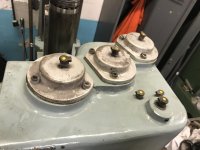Hi guys i have this western radial arm drill press from 1941. Very little use and just about to finally get it ready for operation. Im changing out oil in everything and i need some people to tell me what they think i should use for lubrication in the speed selector housing.
I removed both front and rear covers to find old ass grease that was black and hard like a wax or some kind. Spent all day cleaning that crap out of there and off all the gears. In addition to the black stuff i think there was a different type grease in there too (not certain could be same stuff as black just not solidified) and must have had a graphite or some additive. Almost looked like fine metal particles everywhwere.
So im not finding in the manual where it says to use anything specific in the gear box.
As pictured, i have two oil cups at the top of the head that drip oil down into small holes in a bronze block that rides half way around two gears. Each oil cup goes to each bronze cavity. So im thinking no grease in this gear box, just oil from those oil caps each time i use it?
Seems like i would worry about wether or not i have enough lubrication for everything just doing that. Of course id squirt oil all over everything first before screwing the covers back on but just wondering what others would do????
If i grease the gears what do i use? And can i still oil the cups if i use grease or do we not want mixing to occur?
Thanks so much. This thing is in such good shape i def. dont want to ruin it.
I removed both front and rear covers to find old ass grease that was black and hard like a wax or some kind. Spent all day cleaning that crap out of there and off all the gears. In addition to the black stuff i think there was a different type grease in there too (not certain could be same stuff as black just not solidified) and must have had a graphite or some additive. Almost looked like fine metal particles everywhwere.
So im not finding in the manual where it says to use anything specific in the gear box.
As pictured, i have two oil cups at the top of the head that drip oil down into small holes in a bronze block that rides half way around two gears. Each oil cup goes to each bronze cavity. So im thinking no grease in this gear box, just oil from those oil caps each time i use it?
Seems like i would worry about wether or not i have enough lubrication for everything just doing that. Of course id squirt oil all over everything first before screwing the covers back on but just wondering what others would do????
If i grease the gears what do i use? And can i still oil the cups if i use grease or do we not want mixing to occur?
Thanks so much. This thing is in such good shape i def. dont want to ruin it.






